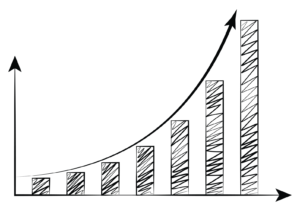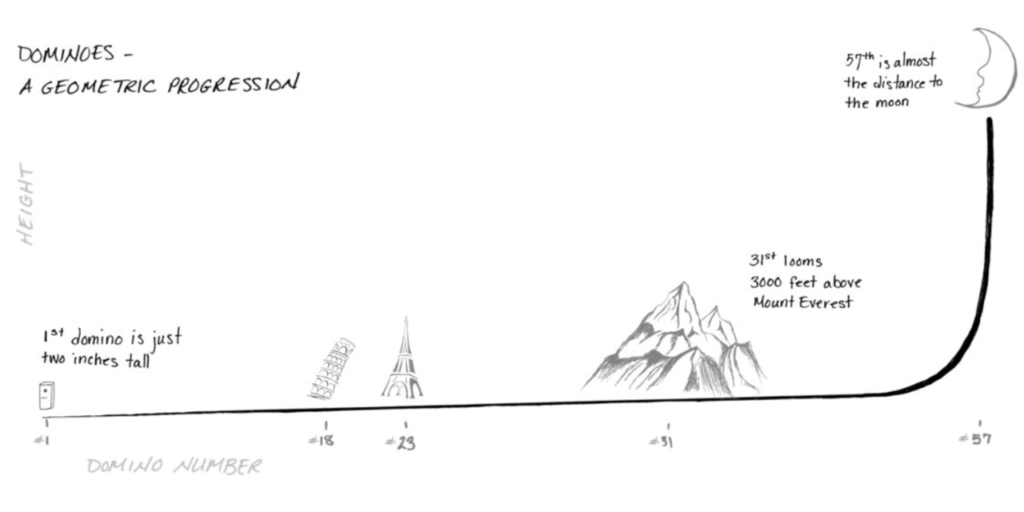Kaizen Culture: Small Steps, Big Wins

The topic of exponential growth has been overdone for sure. At least in a motivational sense it has. We get it, do a little bit every day and in the end you’ll have a lot. But do we actually get it? While the concept itself is overdone, what never ceases to amaze me is how much it is overlooked. But, why? It is so overlooked because of its unfathomable nature. As humans we’re literally floored by the outcome because we can’t fathom its possibility.
Here’s a couple of examples:
If you were to fold a piece of paper in half 50 times how tall would it be? The answer? A typical piece of paper with a width of .004 inches would blow past the moon and get as close as Venus. Do the math. The fascinating part here is you actually want to do the math meaning you’re having a hard time comprehending its nature.
Here is another pretty popular one:
Would you rather have 1 million dollars today or a penny doubled every day for 30 days? Believe it or not the penny doubled everyday is close to 11 million dollars at the end of 30 days.
Last one but from the book The One Thing by Gary Keller and Jay Papasan:
In 1983, Lorne Whitehead wrote in the American Journal of Physics that he’d discovered that domino falls could not only topple many things, they could also topple bigger things. He described how a single domino is capable of bringing down another domino that is actually 50 percent larger.
Do you see the implication? Not only can one knock over others but also others that are successively larger. In 2001 a physicist from San Francisco’s Exploratorium reproduced Whitehead’s experiment by creating eight dominoes out of plywood, each of which was 50 percent larger than the one before. The first was a mere two inches, the last almost three feet tall. The resulting domino fall began with a gentle tick and quickly ended “with a loud SLAM.”
Imagine what would happen if this kept going. If a regular domino fall is a linear progression, Whitehead’s would be described as a geometric progression. The result could defy the imagination. The 10th domino would be almost as tall as NFL quarterback Peyton Manning. By the 18th, you’re looking at a domino that would rival the Leaning Tower of Pisa. The 23rd domino would tower over the Eiffel Tower and the 31st domino would loom over Mount Everest by almost 3,000 feet. Number 57 would practically bridge the distance between the earth and the moon

Kaizen
So you can see how a little effort can create big outcomes. While this is valuable information to help your team succeed by implementing good habits over time, we’ll get to that later. What needs to be introduced first is the philosophy of Kaizen. Google defines Kaizen as a Japanese term meaning change for the better or continuous improvement. This can easily be seen in the same previous examples but we want to look at this through a leadership lens and in terms of coaching performance. Lets let Steven Bartlett, author of The Dairy of a CEO explain:
For 77 years, through ups and downs, General Motors (GM) had led the way, with higher car sales annually than any other company globally. But in recent years they’ve been dethroned by Toyota and its unique approach to building cars, a company and a culture.
Toyota was announced as the world’s leading automaker in terms of sales for another consecutive year in 2022. Their year-on-year growth of 9.2 per cent increased the gap with their closest competitor, Volkswagen, by almost 2 million cars sold, compared to the 250k gap the year before.
Central to the company’s success is something called the Toyota Production System’. It was developed during the post-Second World War era in Japan, when the country was undergoing reconstruction and facing a shortage of capital and equipment. In response to these challenges, Toyota engineer Taiichi Ohno formulated a philosophy that allowed the company to extract the maximum potential from each component, machine and employee.
The secret to Toyota’s philosophy is a principle known by its Japanese name, ‘kaizen, which means ‘continuous improvement. In the kaizen philosophy, innovation is seen as an incremental process; it’s not about making big leaps forward, but rather making small things better, in small ways, everywhere you can, on a daily basis.
The kaizen philosophy vehemently rejects the notion that only a select few members of a company’s hierarchy are responsible for innovation: it insists that it has to be an everyday task and concern of all employees, at all levels.
Because of the kaizen philosophy, Toyota reportedly implements a staggering one million new ideas each year – the majority of which are suggestions made by ordinary factory-floor workers.
Remarkably, Toyota’s US facilities are said to receive a hundred times fewer suggestions from their workers than their Japanese counterparts.
These suggestions are often tiny, including things like increasing the size of water bottles to better hydrate employees, lowering a shelf to make tools slightly easier to reach or making the font on a safety warning just one point size bigger to reduce accidents.
These suggestions may sound insignificant in nature, but the kaizen philosophy believes that it is in fact the smallest of improvements that will cumulatively push the business forward and keep it ahead of competitors that don’t care about sweating the small stuff.
Kaizen philosophy says you must create a standard, make sure everyone meets the standard, ask everyone to find ways to improve the standard, and repeat this process for ever.
Kaizen is not only something to be practiced at a coaching and motivational level. While that is a takeaway and something that can be implemented in your leadership, think more in terms of making this a way the culture operates. Other than the growth being unfathomable for humans, this is the fascinating part of the concept. What we should be doing is asking the team “what is something small that can be improved upon in our department, on our team, or in our company?” No matter how small the operating procedure or way of doing things, that slight improvement, along with others, compounded over time, can create big change for the good!
Taking this as our aim with this concept, here is another example from The Diary of a CEO where Steven speaks with David Brailsford on his revamping of the British Cycling team using the Kaizen philosophy:
A few years ago l interviewed Sir David Brailsford, who is known as the mastermind behind a theory called marginal gains. His theory was popularised by the story of the 2008 British Cycling team and their continued success across multiple Olympic Games.
Prior to 2008, British Cycling was widely regarded as the laughing stock of the sport. In an effort to fix things, the governing body hired performance director David Brailsford to transform the philosophy, strategy and culture of the team.Brailsford believed that 1 per cent improvements across all aspects of cycling would aggregate into a significant performance gain. Under his guidance, British Cycling stopped thinking about major steps forward and started obsessing over the smallest, easiest details: using antibacterial hand gel to cut down on infections, rubbing alcohol on bicycle tyres for better grip, redesigning bike seats for greater comfort, changing the pillows in the athletes’ bedrooms to improve their sleep, extensive wind tunnel testing of bikes and racing suits, etc.
Brailsford took over and within five years, British Cycling won 57 per cent of all road and track cycling gold medals at the 2008 Beijing Olympics, and at the 2012 London Olympics set seven world records and nine Olympic records! From 2007 to 2017, British cyclists won 178 world champion-ships, 66 Olympic or Paralympic gold medals and captured five Tour de France victories. This made this ten-year span the most successful era for any cycling team in history!
In my interview with Brailsford, I asked him how focusing on small marginal progress caused such tremendous motivation, success and consistency, and he told me:
People want a feeling of progression, and if we aim for perfection, we’ll fail, because perfection is so far away.
So instead of perfection, let’s have a little progression, just a little, and that will make us feel good. So, let’s identify the basics, get them right and then next week ask ourselves, what other little things could we do?
There are a million things that could impact a cycling performance. Could we, I don’t know, change our diet to be slightly more optimal than it is this week, and do that by next week? And everybody goes, yep, we could do that! OK. What else could we do? Could we do more in the gym this week? Could we alter our attitude slightly? Could you do that? Yeah, we could do that. OK. So off we go. And then you get to next week and ask, did we do all that stuff? Yeah, we did. We haven’t moved a long way, but I tell you what, it felt pretty good.
And suddenly you kind of start to get this idea that you’re on the move. And when you feel like you’re on the move, you feel good about yourself. Tiny progress means a lot to people, and when they feel it, they realise they can do it again tomorrow.
Whereas when you’re trying to do something big, it’s less sustainable. We all go full gas in the gym in January and then of course by February, we’ve all stopped again. And why is that? It’s quite rare that you can make major change and make it sustainable, but it’s quite easy to make small incremental changes and make them stick. And it’s the stickability over time, I think, which makes the big difference. We never ever thought about the podiums, or the finish line, or trophies – we didn’t talk about that – we thought about the smallest things we could do today to make progress.
When you create this culture, people feel the progress, and they’re energised. Even more ideas start coming to the surface from the team and they get adopted too. And a narrative emerges in the team that we’re on the move, we’re changing, we’re doing all the little things because we can be arsed to do the little things that other people can’t be arsed to do. And that makes a difference.
And I say that quite often in our team, we’ll be working late, and I say, right, guys, let’s just all get together for a minute. The reason we’ve been good, is because we can be arsed to do all these little things that all these other teams who are now locked up and gone to bed in their hotel, can’t be bothered to do. And it works, you know, it works, 100 per cent it works, been at it 20 years. And it’s as much about that kind of enthusiasm and a positivity about embracing and not viewing small change as a chore. Progress is a powerful force.
THE SUPERPOWER OF SMALL WINS:
The concept of progress is often perceived as a tangible outcome, yet research continues to show that the true motivational power of progress is more feelings and emotions than facts and stats.
As researcher Teresa Amabile notes in the Harvard Business Review, ‘On days when workers have the sense they’re making headway in their jobs, or when they receive support that helps them overcome obstacles, their emotions are most positive and their drive to succeed is at its peak.
The key phrase here is ‘when workers have the sense they’re making headway’.
In Leading Teams
We’ve established how impactful this can be in creating something big through small successes and now know this does work. If that is the case, and we know it makes us feel good to get a sense of success, would it not make sense to motivate our teams to see their own small successes and coach them to take steps no mater how small?
No matter your opinion on Jordan Peterson, you can’t deny his logic in this clip with he and Joe Rogan. Peterson claims how important it is to aim low in order for you to establish some semblance of success in order for you to push that first domino.
What To Do As Leaders
Other than gaining insight into where things can improve for the department or team, take what Jordan says here and find something small for those you coach that you can task them with. Something small and easy you know they can commit to so they can get the ball rolling (or dominos falling). Set the bar low enough for them to practically trip over it.
Then, weekly or so, check in on how that new habit is coming. Can we now add to it? Can we make it more challenging but not so much where it becomes too big of a lift?
The reason this works it because that feeling of success has a compounding effect in itself. When that small habit turns into something larger, so does their confidence!
Conclusion
There are three takeaways here: First: Develop your awareness and absorb this mindset and the Kaizen philosophy. Second (for the team) Ask them where things can be better. Even if it is small, execute it and build upon that. Third (for individuals and motivation) find a small habit you know someone can stick to and have them implement it every day. Once it becomes commonplace, take inventory of how they now feel about their progress and add something small to it.
If this can be done and we can hold ourselves accountable to it as leaders, theres no telling how much our progress as a group and individuals can compound!



